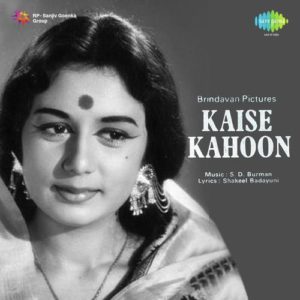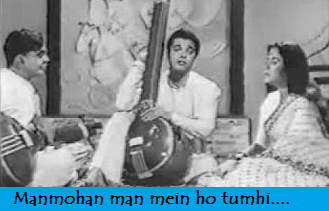Raaga Based Song of the Day: Manmohan man mein ho tumhi…
Raag Adana, Tal Tintal
We have completed twenty-four days of Raaga Based Songs of the Day. Our first post in the series was titled ‘Raaga Based Song Of The Day #1’ and the song was a Mohammad Rafi and Lata Mangeshkar song from the 1970 Shakti Samanta movie Pagla Kahin Ka: Tum mujhe youn bhula na paoge. It is in Raag Jhinjhoti, Tal Kaherava.
Our twenty-fourth post was titled ‘Raaga Based Song Of The Day #24’ and the song was a Lata Mangeshkar song from the 1991 Gulzar movie Lekin: Kesariya baalma. It is in Raag Mand, Tal Dadra.
This blog has a number of posts on Raaga based songs in Hindi movies titled similarly; for example: ‘The Best Raaga Based Songs in Hindi Movies – Raaga Bhairavi – Part II’.
In the last twenty-four days of sharing Raaga based songs of the day, I have given you songs based on Raag Jhinjhoti, Gara, Bhimpalasi, Madhuvanti, Shivaranjani, Bihag, Pahadi, Sarang, Pilu, Bhairavi, Khammaj, Charukesi, Kalyan or Yaman, Desh, Malgunji, Kirwani, Kedar, Bageshri, Megh Malhar, Bhupali, Ahir Bhairav, Malkaush and Mand.
Today, I give you a song in Raag Adana, Tal Tintal.
However, first, lets take up the value added learning of today. Today, we shall learn a little more in detail about Tintal:
I had given you an introduction to Tal (musical measure) on the second day itself. Some of you would recall that I had mentioned that Tal, Taal or Tala is a word that is variation of the word Taali (Clap). Before the advent of Tabla, the standard method of keeping the musical measure was with the clapping or tapping of one’s hand on the arm or thigh. Indeed, now that we have Tabla, this beat is still maintained by clapping and waving of hands. If you recall, I had also mentioned that whilst the Raaga sets the mood, time of day and season of a composition, Tal constitutes the time-cycle. Therefore, a Raaga and Tal go hand in hand. On the 14th Raaga Based Song of the Day, was the only occasion when we didn’t have a Raaga (Kalyan) accompanied by a Tal since the entite composition of Lagata nahin hai dil mera was in Alaap.
The rythmic hand gestures used to denote Tal are called Kriyas. If you recall, I laid emphasis on something called Vibhag or sections or angas or parts of a Tal. In Hindustani music, the first beat of a Vibhag is Tali (Clap), whilst the empty beat (Khali) is indicated is indicated by the sideways wave of the dominant clapping hand. And thus, you would recall, I represented the Tal for you with Claps and Waves.
We had also learnt that a Tal doesn’t have a fixed tempo or laya. Hence, we had learnt three different tempos: Vilambit (delayed or slow), Madhya (medium) and Drut (fast).
Teental or Tintal is the most popular Tal in North India/Hindustani Music. It is also the most symmetrical. It has 16 beats in four vibhags. The period between every two beats is the same. We already know that the first beat is called Sam (to be pronounced like the English word Sum) and the ninth beat is Khali or empty. To perform the kriya of Tintal, one has to clap on the first beat, clap on the 5th beat, then waves on the 9th beat and lastly again claps on the 13th beat; these three claps give the rhythm its name: Teental or Tintal.
| dha | dhin | dhin | dha | | | dha | dhin | dhin | dha | | |
| x | 2 | ||||||||
| dha | tin | tin | ta | | | ta | dhin | dhin | dha | | |
| o | 3 |
This can also be shown using the following figure:
| Taal signs | X | 2 | 0 | 3 | ||||||||||||
| Maatra | 1 | 2 | 3 | 4 | 5 | 6 | 7 | 8 | 9 | 10 | 11 | 12 | 13 | 14 | 15 | 16 |
| Bols | dha | dhin | dhin | dha | dha | dhin | dhin | dha | dha | tin | tin | ta | ta | dhin | dhin | dha |
Raag Adana was earlier called Addana, which used to be a major raaga of the 17th century and used to be a combination of Malhar and Kanada. Because of its association with Kanada, it is also called Adana Kanada. If that reminds you of Darbari Kanada, you are not too much off the mark. The fact is that Adana is often sung or played in drut laya after a vilambit composition in raga Darbari Kanada. Adana is much more straight than Darbari and hence passages faster than vilambit are possible. Adana is a late night raaga to be sung between midnight and 3 AM.
Some of the other Hindi songs composed in Raag Adana are:
| Aapki nazron ne samajha Ai dil mujhe aisi jagah le chal Jhanak Jhanak Payal Jaa Main Tose Manmohan Man Mein Lapak Jhapak Tu Mukh Se Na Boloon Ghar Aaja Meray Jab Ishaq Kahin Ho Jaata Hai Saanware Mat Ja Tumhe Jo bhi Cham Cham Baje Re Dil Ka Fasaana |
Anpadh Arzoo Jhanak Jhanak Payal Bajay Sautela Bhai Kaisay Kahoon Boot Polish Jalianwala Bagh Garam Coat Aarzoo – Majboor Jaane-Anjaane – |
Lata Mangeshkar Talat Mahmood Ustaad Amir Khan & Chorus Lata Mangeshkar Rafi, Suman, S. D. Batish Manna Dey & Chorus Lata Mangeshkar, Talat Lata Mangeshkar Asha Bhosle, Mubarak Begum Lata Mangeshkar Hemant Kumar Manna Dey Manna Dey |
 I have taken today’s song from the 1964 Atma Ram movie Kaise Kahun starring Biswajeet, Nanda, Geetanjali (Remember her? Well she is the one who acted with Mahipal in Parasmani and sang the famous song: Woh jab yaad aaye bahut yaad aaye), Poonam Kapoor, Durga Khote and Manmohan Krishna.
I have taken today’s song from the 1964 Atma Ram movie Kaise Kahun starring Biswajeet, Nanda, Geetanjali (Remember her? Well she is the one who acted with Mahipal in Parasmani and sang the famous song: Woh jab yaad aaye bahut yaad aaye), Poonam Kapoor, Durga Khote and Manmohan Krishna.
Naturally, you would be floored by the lyrics since these were penned by the best ever lyricist: Shakeel Badayuni. The composition is that of SD Burman (post 1959, you would recall that Shakeel came out of the influence of his mentor Naushad Ali and tied up with others such as Ravi and Hemant Kumar.
The song has been sung by Mohammad Rafi singing for Biswajeet, Sudha Malhotra singing for Nanda and SD Batish singing for Manmohan Krishna.
Please enjoy in Raag Adana, Tal Tintal: Manmohan man mein ho tumhi…
shi : a~ tanu~~um aa~ aa~ aa aa~
su : aa~ aa~ aa~ aa~ aa~
shi : aa~ manamohan man me.n ho tumhii.n
ra, su : manamohan man me.n ho tumhii.n
more a.ng a.ng tumhii.n samaaye
jaano ya jaano na ho tumahii
manamohan man ## SDB joins in, R+S fade out ## me.n …
R: manamohan man me.n man me.n
S: ho tumhii.n ho tumhii.n ho tumhii.n
R+S=manamohan man me.n ho tumhii.n
more a.ng a.ng tumhii.n samaaye
jaano yaa jaano naa ho tumhii.n
manamohan ## SDB joins in, R+S fade out ## man me.n …
SDB: dekh dekh torii chhab saa.Nvariyaa
R+S: dekh dekh torii chhab saa.Nvariyaa
banii hai raadhaa tumharii baa.Nvariyaa
rom rom tumhare guN gaaye
maano yaa maano naa ho tumhii.n
manamohan man ## R fade out, S alone ## me.n
R: dekh dekh torii chhab saa.Nvariyaa
S: ho~o bani hai raadha tumharii baa.Nvariyaa
R+S: dekh dekh torii chhab saa.Nvariyaa
banii hai raadhaa tumharii baa.Nvariyaa
rom rom tumhare guN gaaye
maano yaa maano na ho tumhii.n
manamohan man(R fade out, S alone) me.n
R: a~ aa~
S: aa~ aa~ a~
We have intended to learn about Raaga based music whilst we entertain ourselves with Raaga based songs. So, lets, once again, take stock of our collective learning so far:
- On the first day we learnt about the Raaga system devised by Pandit Vishnu Narayan Bhatkhande, which is the prevalent system in Hindustani Classical Music and based on ten Thaats.
- On the second day we learnt about Tal or Taal.
- On the third day we learnt about characteristics of Raagas that included Swar, Jati, Thaat, Arohana and Avarohana, Vadi, Samvadi and Pakad.
- On the fourth day, we learnt about Sargam.
- On the fifth day, we learnt about notations used in Indian classical music or simply Swar Lipi.
- On the sixth day, we learnt about the Ras (sentiments) that Raagas evoke.
- On the seventh day, we learnt about various types of Swar: Shuddha, Achal, Vikrut, Komal and Teevra.
- On the eighth day, we learnt the parts of a composition in Indian Classical Music.
- On the ninth day, we learnt the names of some of the popular instruments used in Indian Classical Music.
- On the tenth day, we learnt about the sources of names of Raagas.
- On the eleventh day, we learnt about why Bhairavi is the first raag to be taught to beginners and also why it is the last in a performance.
- On the twelfth day, we learnt about Khammaj Thaat.
- On the thirteenth day, we learnt about Tal Punjabi Theka or Sitarkhani.
- On the fourteenth day, we learnt about Alap.
- On the fifteenth day, we learnt about List of Raagas (Raagmala) in my favourite book: Sri Guru Granth Sahib.
- On the sixteenth day, we learnt about tips for raaga identification.
- On the seventeenth day, we learnt the basics of Gharana system.
- On the eighteenth day, we learnt about Filmi Sangeet.
- On the nineteenth day, we learnt about the commonest Tal in Raagas: Tintal.
- On the twentieth day, we learnt about the Kafi Thaat.
- On the twenty-first day, we learnt a little more in detail about the classification of Raagas.
- On the twenty-second day, we learnt the essential differences between Bhairavi and Bhairav.
- On the twenty-third day, we learnt a little more in detail about the Jati or Jaati of a raaga.
- On the twenty-fourth day, we learnt details of Thaat Bilawal, the most basic thaat in the Bhatkhande’s system of raagas.
- And today, on the twenty-fifth day, we learnt about Tintal.
There is much more still to be learnt and enjoyed.
Please stay tuned!
